- Startseite
- Über uns
- Industrie
- Dienstleistungen
- Lesen
- Kontaktieren Sie uns
Markt für Softwarelösungen für den Wasserstraßentransport: Aktuelle Analyse und Prognose (2024-2032)
Schwerpunkt auf Lösungen (Lagerhaltung, Schiffsverfolgung, Frachtsicherheit, Yard Management, Audit & Claim und Schiffsbroker-Software); Dienstleistungen (Managed Services, Beratungs-/Customization Services und Schulungsdienstleistungen); Branchen (Konsumgüter & Einzelhandel, Öl & Gas, Industrie & Fertigung, Energie & Bergbau, Luft- und Raumfahrt & Verteidigung, Bauwesen, Chemie, Pharma & Gesundheitswesen sowie Lebensmittel & Getränke); und Region/Land
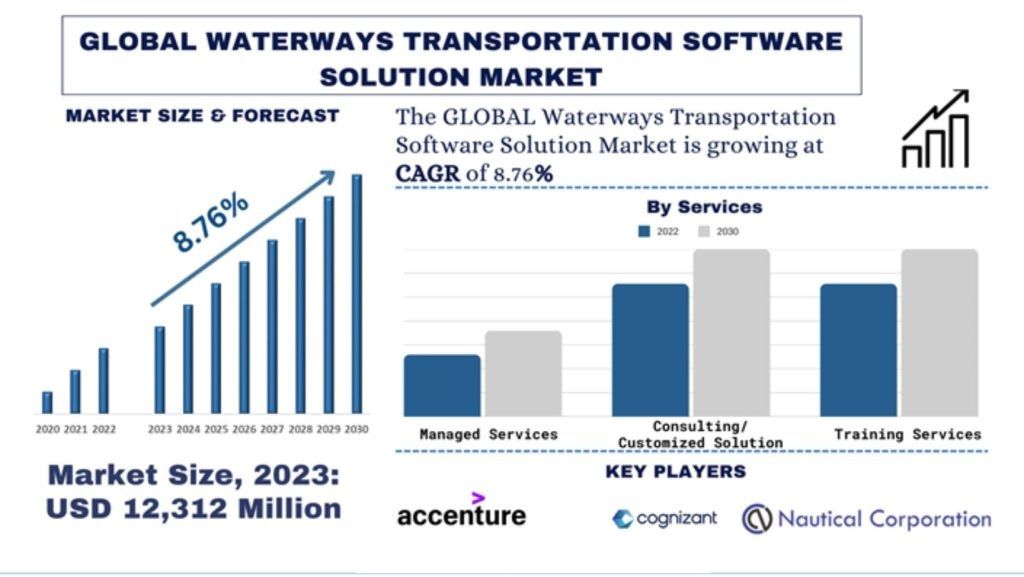
Waterway Transportation Software Solutions Marktumfang & Prognose
Der Waterway Transportation Software Solutions Markt wurde auf 12.312 Millionen USD geschätzt und wird voraussichtlich mit einer starken CAGR von rund 8,76 % während des Prognosezeitraums (2024-2032) wachsen, was auf den wachsenden Bedarf an betrieblicher Effizienz und Kostenoptimierung in der gesamten Lieferkette weltweit zurückzuführen ist.
Waterway Transportation Software Solutions Marktanalyse
Waterway Transportation Software Solutions sind technologische Werkzeuge, die entwickelt wurden, um Abläufe innerhalb der Wassertransportbranche zu optimieren und zu rationalisieren. Diese Softwarelösungen decken verschiedene Aspekte ab, wie z. B. Routenplanung, Frachtmanagement, Schiffsverfolgung, Einhaltung gesetzlicher Vorschriften und die allgemeine Effizienzverbesserung im Wassertransport.
In einer Ära, in der Kostenoptimierung und operative Agilität von größter Bedeutung sind, wenden sich die Akteure des Wassertransports an ausgefeilte Softwarelösungen, um ihre Prozesse zu optimieren. Diese Lösungen ermöglichen Echtzeit-Tracking, Routenplanung, Frachtmanagement und nahtlose Kommunikation zwischen verschiedenen Akteuren, was zu reduzierten Betriebskosten, minimierten Verzögerungen und einer verbesserten Gesamteffizienz führt. Darüber hinaus haben die Globalisierung und die ständig wachsende Komplexität der Lieferketten den Bedarf an End-to-End-Transparenz erhöht. Waterway Transportation Software Solutions bieten Echtzeit-Tracking-Funktionen, die es den Beteiligten ermöglichen, Frachtbewegungen zu überwachen, potenzielle Störungen vorherzusehen und fundierte Entscheidungen zu treffen, um Risiken zu mindern und Lieferkettenabläufe zu optimieren.
Waterway Transportation Software Solutions Markttrends
Dieser Abschnitt befasst sich mit den wichtigsten Markttrends, die die verschiedenen Segmente des Waterway Transportation Software Solutions Marktes beeinflussen, wie sie von unserem Team von Forschungsexperten identifiziert wurden.
Die Öl- und Gasindustrie ist weltweit ein herausragendes Segment in Bezug auf die Umsatzgenerierung für Waterway Transportation Software Solutions.
Die Öl- und Gasindustrie hat sich als wichtiges Endverbrauchersegment für Softwarelösungen für den Wassertransport etabliert. Die Öl- und Gasindustrie ist stark auf den Wassertransport für die Beförderung von Rohstoffen wie Rohöl und Erdgas sowie für den Vertrieb von raffinierten Produkten wie Benzin, Diesel und Petrochemikalien angewiesen. Der Großteil des globalen Öl- und Gashandels erfolgt über den Seetransport, was eine effiziente Wasserweglogistik für diese Industrie unerlässlich macht. Die Öl- und Gasindustrie agiert auf globaler Ebene, wobei sich Produktions- und Raffinerieanlagen in verschiedenen Teilen der Welt befinden. Dies erfordert den Transport von Ressourcen und Produkten über große Entfernungen, oft unter Einbeziehung mehrerer Transportarten, einschließlich Wasserwege. Waterway Transportation Software Solutions helfen bei der Optimierung von Routen, der Verwaltung der Logistik und der Sicherstellung effizienter Lieferkettenabläufe. Darüber hinaus betreibt die Öl- und Gasindustrie eine bedeutende Flotte von Schiffen, darunter Tanker, Binnenschiffe und Unterstützungsschiffe. Waterway Transportation Software Solutions bieten effiziente Flottenmanagementfunktionen, die es Unternehmen ermöglichen, Schiffsbewegungen zu verfolgen, die Leistung zu überwachen und die Schiffsauslastung zu optimieren, wodurch die entscheidende Rolle von Waterway Transportation Software Solutions im effizienten Betrieb der Flotte weiter gefestigt wird. Dies führt zu einem sprunghaften Anstieg der Nachfrage nach Softwaresystemen.
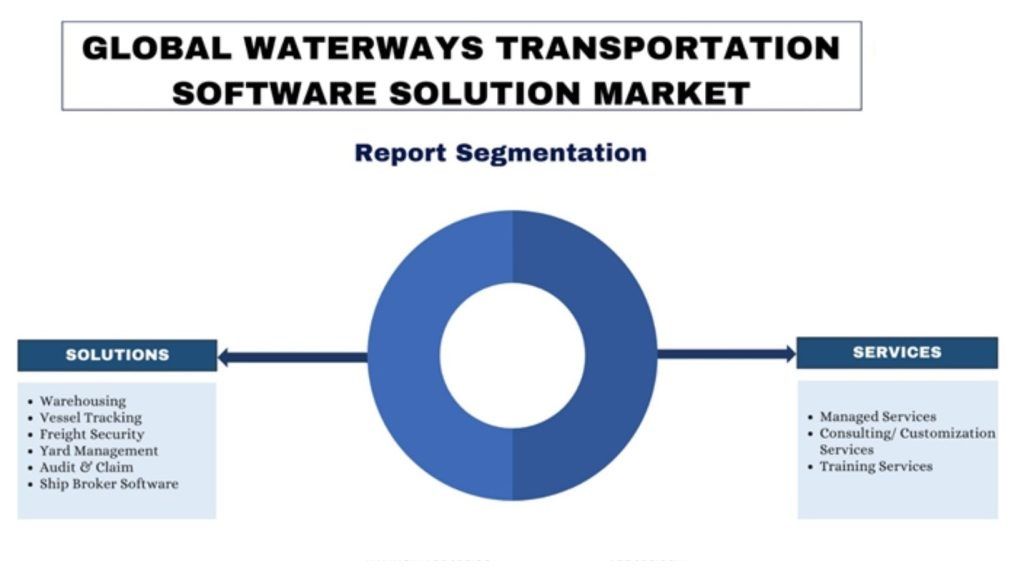
Der asiatisch-pazifische Raum ist der am schnellsten wachsende Waterway Transportation Software Solutions Markt weltweit.
Innerhalb des asiatisch-pazifischen Raums hält China einen großen Marktanteil. Der Hauptfaktor, der das Wachstum des Marktes ankurbelt, ist, dass China einige der verkehrsreichsten Häfen und Schifffahrtszentren der Welt im ganzen Land beherbergt und ein dominierender Akteur auf dem globalen Exportmarkt ist.
Der asiatisch-pazifische Raum hat sich zum führenden Markt für Waterway Transportation Software Solutions entwickelt, der die maximale Nachfrage generiert und einen bedeutenden Teil des globalen Marktanteils hält. Der asiatisch-pazifische Raum beherbergt einige der verkehrsreichsten Häfen und Schifffahrtszentren der Welt, wie Singapur, Shanghai, Shenzhen und Busan. Die strategische Lage der Region entlang wichtiger maritimer Handelsrouten hat zu einem deutlichen Anstieg des Seehandels und der Schifffahrtsaktivitäten geführt. Dieser Anstieg des Handels hat einen dringenden Bedarf an effizienten Waterway Transportation Software Solutions geschaffen, um Abläufe zu rationalisieren, die Logistik zu optimieren und das Lieferkettenmanagement zu verbessern. Darüber hinaus haben mehrere Länder im asiatisch-pazifischen Raum, darunter China, Indien und südostasiatische Nationen, in den letzten Jahrzehnten eine rasche Industrialisierung und ein schnelles Wirtschaftswachstum erlebt. Dieses Wachstum hat zu einer gestiegenen Nachfrage nach dem Import und Export von Rohstoffen, Fertigwaren und Industrieprodukten geführt, was den Bedarf an robusten Waterway Transportation Software Solutions zur Verwaltung der komplexen Logistik des internationalen Handels erhöht. Darüber hinaus haben die Regierungen im asiatisch-pazifischen Raum die Bedeutung eines effizienten Wassertransports erkannt und verschiedene Initiativen und Richtlinien zur Förderung der Einführung fortschrittlicher Softwarelösungen umgesetzt. Länder wie China, Singapur und Südkorea haben stark in die Entwicklung modernster Hafeninfrastruktur und die Umsetzung von Initiativen zur digitalen Transformation investiert, wodurch ein günstiges Umfeld für die Einführung von Waterway Transportation Software Solutions geschaffen wurde.
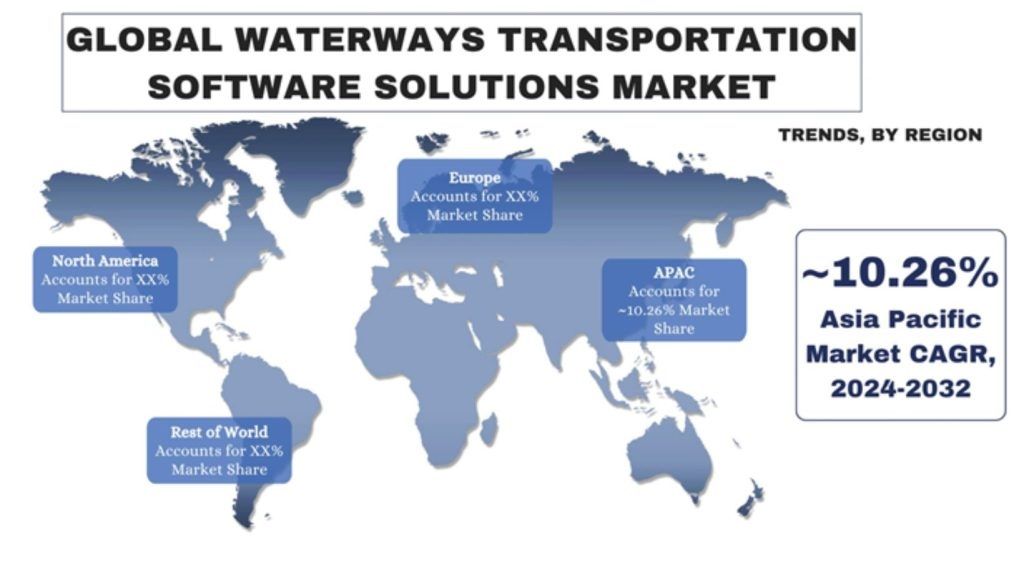
Waterway Transportation Software Solutions Branchenüberblick
Der Waterway Transportation Software Solutions Markt ist wettbewerbsintensiv und fragmentiert, mit der Präsenz mehrerer globaler und internationaler Marktteilnehmer. Die wichtigsten Akteure verfolgen verschiedene Wachstumsstrategien, um ihre Marktpräsenz zu verbessern, wie z. B. Partnerschaften, Vereinbarungen, Kooperationen, neue Produkteinführungen, geografische Expansionen sowie Fusionen und Übernahmen. Einige der wichtigsten Akteure, die auf dem Markt tätig sind, sind Cognizant; Accenture; Nautical Corporation; The Descartes Systems Group Inc; Veson Nautical; Körber AG; SAP; BASS Software Ltd; Grandi Navi Veloci S.p.A.; und Zebra Technologies Corp
Waterway Transportation Software Solutions Marktnachrichten
- Im Juni 2024 ging die Parsons Corporation eine Partnerschaft mit dem Hafen von Oakland, Kalifornien, Advent eModal, Mobile Programming und anderen wichtigen Interessengruppen ein, um das Freight Intelligent Transportation System (FITS) im Hafen einzuführen. Seit 2020 arbeitet Parsons mit verschiedenen Organisationen zusammen, darunter die Alameda County Transportation Commission (CTC), die Mitarbeiter des Hafens, die Stadt Oakland, das California Department of Transportation und Subunternehmer, um die FITS-Lösung zu entwickeln und zu implementieren. Der Bau und die Systemintegration sind abgeschlossen, und der Hafen von Oakland geht nun in die Phase des laufenden Betriebs und der Wartung (O&M) über. Die fortschrittliche Verkehrsmanagementsoftware iNET® von Parsons arbeitet zusammen mit dem intelligenten Parksystem SecūrSpace und der neuen GoPort-Website und mobilen Anwendung, um die Effizienz, Sicherheit, den Betrieb, die Zirkulation und die Zuverlässigkeit des Lkw- und Bahnverkehrs im Hafen zu verbessern.
- Im November 2023 hat das Port Infrastructure Development Program (PIDP) der U.S. Department of Transportation's Maritime Administration (MARAD) kürzlich mehr als 653 Millionen USD zur Unterstützung von 41 Hafenausbauprojekten im ganzen Land bereitgestellt. Diese Finanzierung, die Teil der Investing in America-Agenda von Präsident Biden ist, zielt darauf ab, die Kapazität und Effizienz von Küstenhäfen, Great Lakes-Häfen und Binnenflusshäfen zu verbessern. Es ist erwähnenswert, dass ein erheblicher Teil des nationalen und internationalen US-Handels mit einem Gewicht von über 2,3 Milliarden Short Tons auf den Wassertransport angewiesen ist. Die Umsetzung dieser Hafenausbauprojekte wird nicht nur die Zuverlässigkeit der Lieferkette stärken, sondern auch Möglichkeiten für die Entwicklung der Arbeitskräfte schaffen. Darüber hinaus wird sie die Warenbewegung beschleunigen und die Sicherheit, Zuverlässigkeit und Widerstandsfähigkeit der Häfen verbessern.
Waterway Transportation Software Solutions Marktberichtsabdeckung
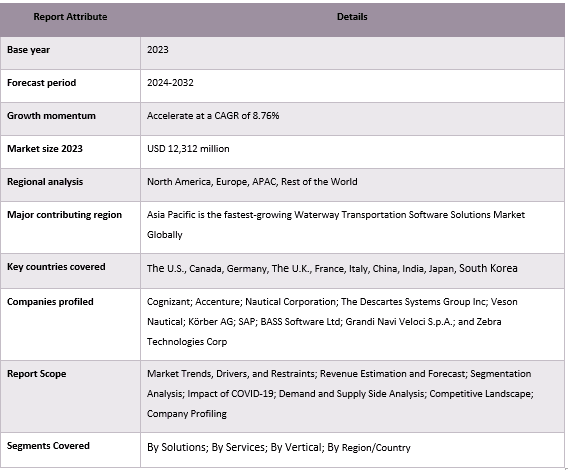
Gründe für den Kauf dieses Berichts:
- Die Studie umfasst eine Marktumfangs- und Prognoseanalyse, die von authentifizierten wichtigen Branchenexperten validiert wurde.
- Der Bericht bietet einen schnellen Überblick über die Gesamtleistung der Branche auf einen Blick.
- Der Bericht enthält eine eingehende Analyse der wichtigsten Branchenkollegen mit einem primären Fokus auf wichtige Finanzkennzahlen, Produktportfolios, Expansionsstrategien und aktuelle Entwicklungen.
- Detaillierte Untersuchung der Triebkräfte, Hemmnisse, wichtigsten Trends und Chancen, die in der Branche vorherrschen.
- Die Studie deckt den Markt umfassend über verschiedene Segmente hinweg ab.
- Tiefgreifende regionale Analyse der Branche.
Anpassungsoptionen:
Der Global Waterway Transportation Software Solutions Markt kann gemäß den Anforderungen oder einem anderen Marktsegment weiter angepasst werden. Darüber hinaus versteht UMI, dass Sie möglicherweise Ihre eigenen geschäftlichen Anforderungen haben. Zögern Sie daher nicht, uns zu kontaktieren, um einen Bericht zu erhalten, der Ihren Anforderungen vollständig entspricht.
Inhaltsverzeichnis
Forschungsmethodik für die Marktanalyse für Softwarelösungen für den Wasserstraßentransport (2024-2032)
Die Analyse des historischen Marktes, die Schätzung des aktuellen Marktes und die Prognose des zukünftigen Marktes für den globalen Markt für Softwarelösungen für den Wasserstraßentransport waren die drei wichtigsten Schritte, die unternommen wurden, um die Einführung von Softwarelösungen für den Wasserstraßentransport in wichtigen Regionen weltweit zu erstellen und zu analysieren. Es wurden umfangreiche Sekundärrecherchen durchgeführt, um die historischen Marktzahlen zu erfassen und die aktuelle Marktgröße zu schätzen. Zweitens wurden zahlreiche Erkenntnisse und Annahmen berücksichtigt, um diese Erkenntnisse zu validieren. Darüber hinaus wurden ausführliche Primärinterviews mit Branchenexperten entlang der Wertschöpfungskette des globalen Marktes für Softwarelösungen für den Wasserstraßentransport geführt. Nach der Annahme und Validierung der Marktzahlen durch Primärinterviews verwendeten wir einen Top-Down/Bottom-Up-Ansatz, um die vollständige Marktgröße zu prognostizieren. Danach wurden Marktaufschlüsselungs- und Datentriangulationsmethoden angewendet, um die Marktgröße von Segmenten und Untersegmenten der Branche, auf die sie sich bezieht, zu schätzen und zu analysieren. Die detaillierte Methodik wird im Folgenden erläutert:
Analyse der historischen Marktgröße
Schritt 1: Eingehende Untersuchung von Sekundärquellen:
Es wurde eine detaillierte Sekundärstudie durchgeführt, um die historische Marktgröße des Marktes für Softwarelösungen für den Wasserstraßentransport aus unternehmensinternen Quellen wie Jahresberichten und Finanzberichten, Performance-Präsentationen, Pressemitteilungen usw. sowie aus externen Quellen wie Fachzeitschriften, Nachrichten und Artikeln, Regierungsveröffentlichungen, Wettbewerberveröffentlichungen, Branchenberichten, Datenbanken von Drittanbietern und anderen glaubwürdigen Veröffentlichungen zu erhalten.
Schritt 2: Marktsegmentierung:
Nachdem wir die historische Marktgröße des Marktes für Softwarelösungen für den Wasserstraßentransport ermittelt hatten, führten wir eine detaillierte Sekundäranalyse durch, um historische Markteinblicke und Marktanteile für verschiedene Segmente und Untersegmente für wichtige Regionen zu sammeln. Die wichtigsten im Bericht enthaltenen Segmente sind Lösungen, Dienstleistungen und Branchen. Darüber hinaus wurden Länderanalysen durchgeführt, um die allgemeine Akzeptanz von Testmodellen in dieser Region zu bewerten.
Schritt 3: Faktorenanalyse:
Nachdem wir die historische Marktgröße verschiedener Segmente und Untersegmente ermittelt hatten, führten wir eine detaillierte Faktorenanalyse durch, um die aktuelle Marktgröße des Marktes für Softwarelösungen für den Wasserstraßentransport zu schätzen. Darüber hinaus führten wir eine Faktorenanalyse unter Verwendung von abhängigen und unabhängigen Variablen wie Lösungen, Dienstleistungen und Branchen des Marktes für Softwarelösungen für den Wasserstraßentransport durch. Es wurde eine gründliche Analyse der Angebots- und Nachfrageszenarien unter Berücksichtigung von Top-Partnerschaften, Fusionen und Übernahmen, Geschäftsausweitungen und Produkteinführungen im Bereich des Marktes für Softwarelösungen für den Wasserstraßentransport weltweit durchgeführt.
Aktuelle Marktgrößenschätzung & Prognose
Aktuelle Marktgröße: Basierend auf den umsetzbaren Erkenntnissen aus den oben genannten 3 Schritten haben wir die aktuelle Marktgröße, die wichtigsten Akteure auf dem globalen Markt für Softwarelösungen für den Wasserstraßentransport und die Marktanteile der Segmente ermittelt. Alle erforderlichen prozentualen Anteile und Marktaufschlüsselungen wurden anhand des oben genannten sekundären Ansatzes ermittelt und durch Primärinterviews verifiziert.
Schätzung & Prognose: Für die Marktschätzung und -prognose wurden verschiedenen Faktoren Gewichte zugewiesen, darunter Treiber & Trends, Beschränkungen und Chancen für die Stakeholder. Nach der Analyse dieser Faktoren wurden relevante Prognosetechniken, d. h. der Top-Down/Bottom-Up-Ansatz, angewendet, um die Marktprognose für 2030 für verschiedene Segmente und Untersegmente in den wichtigsten Märkten weltweit zu erstellen. Die Forschungsmethodik zur Schätzung der Marktgröße umfasst:
- Die Marktgröße der Branche in Bezug auf den Umsatz (USD) und die Akzeptanzrate des Marktes für Softwarelösungen für den Wasserstraßentransport in den wichtigsten Märkten im Inland
- Alle prozentualen Anteile, Aufteilungen und Aufschlüsselungen von Marktsegmenten und Untersegmenten
- Die wichtigsten Akteure auf dem globalen Markt für Softwarelösungen für den Wasserstraßentransport in Bezug auf die angebotenen Produkte. Außerdem die von diesen Akteuren angewandten Wachstumsstrategien, um im schnell wachsenden Markt zu bestehen.
Validierung von Marktgröße und Marktanteil
Primärforschung: Es wurden ausführliche Interviews mit den Key Opinion Leaders (KOLs) geführt, darunter Top Level Executives (CXO/VPs, Vertriebsleiter, Marketingleiter, Betriebsleiter, Regionalleiter, Länderleiter usw.) in wichtigen Regionen. Die Ergebnisse der Primärforschung wurden dann zusammengefasst und eine statistische Analyse durchgeführt, um die aufgestellte Hypothese zu beweisen. Die Ergebnisse der Primärforschung wurden mit den sekundären Erkenntnissen zusammengeführt, wodurch Informationen in umsetzbare Erkenntnisse umgewandelt wurden.
Aufteilung der Hauptteilnehmer in den verschiedenen Regionen
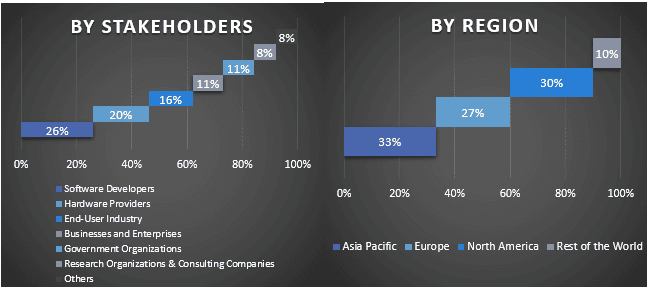
Marktgestaltung
Die Datentriangulationstechnik wurde angewendet, um die Gesamtmarktschätzung abzuschließen und präzise statistische Zahlen für jedes Segment und Untersegment des globalen Marktes für Softwarelösungen für den Wasserstraßentransport zu erhalten. Die Daten wurden in mehrere Segmente und Untersegmente aufgeteilt, nachdem verschiedene Parameter und Trends in den Bereichen Lösungen, Dienstleistungen und Branchen auf dem globalen Markt für Softwarelösungen für den Wasserstraßentransport untersucht worden waren.
Das Hauptziel der globalen Studie zum Markt für Softwarelösungen für den Wasserstraßentransport
Die aktuellen und zukünftigen Markttrends des globalen Marktes für Softwarelösungen für den Wasserstraßentransport wurden in der Studie genau bestimmt. Investoren können strategische Einblicke gewinnen, um ihre Entscheidungen für Investitionen auf der Grundlage der in der Studie durchgeführten qualitativen und quantitativen Analyse zu treffen. Aktuelle und zukünftige Markttrends bestimmten die allgemeine Attraktivität des Marktes auf regionaler Ebene und boten dem Industrieteilnehmer eine Plattform, um den unerschlossenen Markt zu nutzen, um von einem First-Mover-Vorteil zu profitieren. Weitere quantitative Ziele der Studien sind:
- Analyse der aktuellen und prognostizierten Marktgröße des Marktes für Softwarelösungen für den Wasserstraßentransport in Bezug auf den Wert (USD). Analysieren Sie auch die aktuelle und prognostizierte Marktgröße verschiedener Segmente und Untersegmente.
- Die Segmente in der Studie umfassen die Bereiche Lösungen, Dienstleistungen und Branchen.
- Definieren und analysieren Sie den regulatorischen Rahmen für die Softwarelösungen für den Wasserstraßentransport
- Analysieren Sie die Wertschöpfungskette, die mit der Anwesenheit verschiedener Vermittler verbunden ist, und analysieren Sie das Kunden- und Wettbewerberverhalten der Branche
- Analyse der aktuellen und prognostizierten Marktgröße des Marktes für Softwarelösungen für den Wasserstraßentransport für die Hauptregion
- Zu den wichtigsten Ländern der in dem Bericht untersuchten Regionen gehören der asiatisch-pazifische Raum, Europa, Nordamerika und der Rest der Welt
- Unternehmensprofile des Marktes für Softwarelösungen für den Wasserstraßentransport und die von den Marktteilnehmern angewandten Wachstumsstrategien, um sich im schnell wachsenden Markt zu behaupten.
- Detaillierte regionale Analyse der Branche
Häufig gestellte Fragen FAQs
F1: Wie groß ist die aktuelle Marktgröße und das Wachstumspotenzial des globalen Marktes für Softwarelösungen für den Wasserstraßentransport?
F2: Was sind die treibenden Faktoren für das Wachstum des globalen Marktes für Waterway Transportation Software Solutions?
F3: Welches Segment ist das am schnellsten wachsende des globalen Marktes für Softwarelösungen für den Wasserstraßentransport nach Vertikalen?
F4: Welche aufkommenden Technologien und Trends gibt es auf dem globalen Markt für Softwarelösungen für Wasserstraßentransporte?
F5: Welche Region wird der am schnellsten wachsende globale Markt für Waterway Transportation Software Solutions sein?
F6: Wer sind die Hauptakteure auf dem globalen Markt für Softwarelösungen für Wasserstraßentransporte?
Verwandt Berichte
Kunden, die diesen Artikel gekauft haben, kauften auch










